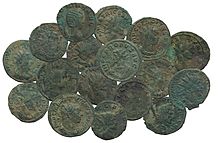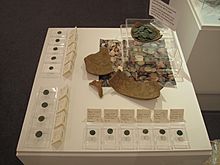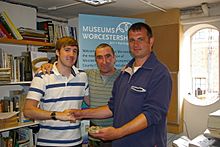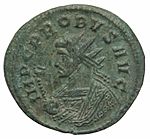Bredon Hill Hoard facts for kids
Quick facts for kids Bredon Hill Hoard |
|
|---|---|

Selection of coins from the Bredon Hill Hoard
|
|
| Material | Debased Silver |
| Size | 3,784 coins |
| Created | 3rd century |
| Period/culture | Romano-British |
| Discovered | June 2011 Bredon Hill, Worcestershire 52°03′54″N 2°03′50″W / 52.064899°N 2.063963°W |
| Present location | Worcester City Art Gallery & Museum |
The Bredon Hill Hoard is a huge collection of 3,784 ancient Roman coins. These coins are made of silver that has been "debased," meaning it was mixed with other, cheaper metals. Two metal detector enthusiasts found the hoard in June 2011. They found it buried in a clay pot on Bredon Hill in Worcestershire, England. The pot was hidden inside a Roman villa (an ancient Roman country house). This amazing find is the largest collection of Roman coins ever discovered in Worcestershire.
Contents
How the Hoard Was Found
Two friends, Jethro Carpenter and Mark Gilmour, found the hoard on June 18, 2011. They often used their metal detectors on Bredon Hill, always with the landowner's permission. Their detector signaled a metal object. They first found a nail, but the detector kept beeping.
They dug deeper and found pieces of pottery. Then, they saw some coins about 50 centimeters (about 20 inches) underground. When they realized there were many coins, they carefully filled the hole back in. On June 20, they reported their discovery to Richard Henry. He is a local expert who helps record archaeological finds.
Digging Up the Hoard
Archaeologists quickly visited the site on June 21 for a first look. Then, a full excavation (a careful digging process) began in early July. This dig lasted for two weeks.
The excavation showed that the coins were buried inside the remains of a Roman villa. This was quite unusual. Most Roman hoards were buried in open fields, far from buildings. The archaeologists found three different layers of ground at the site. The lowest layer had stone foundations from a villa built with wood. It contained items and coins from the 2nd and late 3rd centuries.
The next layer had holes where wooden posts once stood. This showed there was a wooden building there. Pottery from the 3rd or 4th century was found here, along with two coins from the late 3rd century. The top layer was made of rubble and pottery from the late 4th or early 5th century. The coin hoard was buried in a hole dug through this top layer. A single coin found nearby dated to about 355–361 AD. This suggests the hoard was buried around the mid-4th century. This was almost 100 years after the newest coins in the pot were made.
After the coins were carefully removed from the soil, they were dried. On July 15, the coins, which weighed 11 kilograms (about 24 pounds), were taken to the British Museum in London. There, experts cleaned and identified them.
What Was Found in the Hoard
The Bredon Hill Hoard contains 3,874 "radiate" coins. These coins were made between 244 and 282 AD. They include coins from ten emperors of the main Roman Empire. They also include coins from six emperors of the "Gallic Empire." This was a part of the Roman Empire that broke away for a short time. The coins were found inside a clay pot. This pot was a type called "Severn Valley ware," also from the 3rd century.
| Reign | Date | Number of coins | Empire |
|---|---|---|---|
| Philippus II | 247–249 | 1 | Central Empire |
| Saloninus | 259 or 260 | 2 | Central Empire |
| Valerian I | 253–260 | 1 | Central Empire |
| Gallienus | 260–268 | 433 | Central Empire |
| Salonina (wife of Gallienus) | 253–268 | 48 | Central Empire |
| Claudius II | 268–270 | 352 | Central Empire |
| Divus Claudius | 270–271 | 77 | Central Empire |
| Quintillus | 270 | 23 | Central Empire |
| Aurelian | 270–275 | 17 | Central Empire |
| Tacitus | 275–276 | 15 | Central Empire |
| Florian | 276 | 3 | Central Empire |
| Probus | 276–282 | 36 | Central Empire |
| Postumus | 260–269 | 67 | Gallic Empire |
| Laelian | 269 | 7 | Gallic Empire |
| Marius | 269 | 9 | Gallic Empire |
| Victorinus | 269–271 | 817 | Gallic Empire |
| Divus Victorinus | 271 | 1 | Gallic Empire |
| Tetricus I | 271–274 | 1,159 | Gallic Empire |
| Tetricus II | 272–274 | 485 | Gallic Empire |
| Uncertain | 212 | ||
| Copies | 42 | ||
| Illegible | 67 |
Even though these coins were supposed to be silver, most of them were "debased." This means they contained very little silver, sometimes as low as 1%. The rest was mostly copper. Some coins made after a money reform by Emperor Aurelian in 274 had a bit more silver, about 5%.
The coins were made by hand. Because of this, many have small mistakes. Some were struck unevenly, or hit twice. There are also coins where the front and back designs don't match. Sometimes, two blank coins were struck together. This resulted in one coin with a blank back and another with a blank front.
What Happens Next and Where to See It

On November 16, 2011, a special meeting called a "coroner's treasure inquest" was held. This meeting decided that the coins were "treasure." This means they officially belong to the Crown (the government).
Under the rules of the 1996 Treasure Act, the coins will be officially valued by a special committee. After they are valued, a museum can buy them. If a museum buys the hoard, the money will be shared between the people who found the coins and the landowner. This acts as a reward for their discovery.
The Worcester City Art Gallery & Museum wants to buy the hoard. They have started asking the public for donations to help raise the money. Some of the coins from the hoard were shown at the museum for a short time. This temporary display was from October 22 to November 26, 2011.



